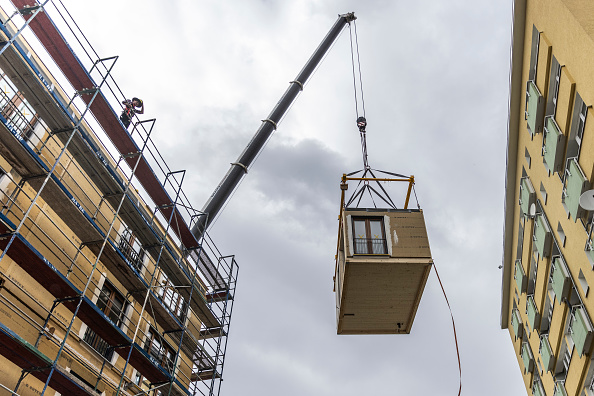Solve the housing crisis and net zero? Your home might be built Ikea-style

If you find yourself on a walk in West Hampstead, it’s worth checking out a two-bedroom apartment called Camden Passivhaus. With its wooden exteriors, it is simple and elegant – a small gem hidden among terrace houses. It’s the first net zero house in the UK – meaning there were no emissions produced during its construction. It’s incredibly energy efficient: compared to existing housing, it achieves a heat saving of 90 per cent. What makes it so special is its modular nature.
Modular housing is a construction technique that’s existed for some time: in the UK, it helped deliver much needed housing after the end of the Second World War. It means houses are built in factories, not on site. As a consequence, material waste is reduced and the process is much quicker as builders don’t have to depend on the weather. Modular flats are also much more energy efficient than the average leaky, uninsulated Victorian house.
According to Professor Avi Friedman – who has extensively researched modular housing – when buildings are being constructed in a controlled environment like a pre-fabrication plant, “the quality is better than on site building”. These houses are so well-designed that even a trained eye struggles to tell the difference between a flat built in a factory and one built on site.
Modular is a cheaper, quicker, more sustainable way of building. It saves energy – now a pressing priority for everyone during a cost-of-living crisis. It’s basically a no brainer. Then why is the UK not a stronghold of modular housing, given the crippling housing crisis that besets it?
The reason has to do more with social perception than with any real pitfall in the method of construction – in short, it has a bad rap. There’s still stigma attached to the concept of building homes in this way: people want their homes to be special, and struggle to trust that a product that can be repeated multiple times can be so. “If someone says pre-fab, people think of 1970s pre-fab housing that was pretty shocking,” says Ian Burdett of Investec Real Estate. He knows the ins and outs of financing modular schemes, and is aware that stigma is a challenge to overcome.
Yet modular is very different today – it means innovative, state-of-the-art design. The UK is finally waking up to this reality, while other countries have been heavily investing in modular schemes for a while. In Japan, one third of all newly built homes are made in factories every year. Modular houses are considered of better quality, so they’re actually more expensive than traditionally built homes. People trust modular architects, and know they can still make their home special by choosing specific features – how many rooms, how to arrange them – even though other flats will look exactly the same as theirs. This has already been exported elsewhere in Europe: 23 per cent of Germany’s stock is modular.
That’s the tension within modular housing: people don’t like the repetition, the mass customisation, but that is exactly what makes modular housing cheaper to build. Mass customisation works very well for cars – you get a fixed model, you can play with the interiors – so modular architects want to prove it can work for houses too. And it can, especially when it caters to student accommodations, affordable housing and blocks of flats. Imagine Camden Passivhaus, but make it 60 flats.
Plus at a time when locals are getting an increased say in how housing pans out in their cities and towns, modular can “reduce disruption to local communities” thanks to most of the work being done away from site, says Andrew Shepherd, managing director at TopHat, a construction company acquired by Goldman Sachs in 2019.
The reasons are all there to embrace pre-fabrication. Now it’s just about seizing the opportunity. The market signs are encouraging: Berkeley Homes and Barratt Developments, for instance, have invested in factories across the UK to increase the output of modular construction. Given the price of building materials has soared in the last year, more house builders are likely to turn to modular to save costs through waste reduction.
Before getting thrown out of the race, Tory leadership candidate Penny Mordaunt pledged to ensure the modular sector gets the incentives and investment it deserves. This shows political appetite that will hopefully be picked up by our new prime minister Liz Truss.
If the builders, the renters and buyers embrace a little bit of open-mindedness, we will all scoop the price. To make a dent in solving the housing crisis, we’ll need a lot more laser-like focus on quality, price and speed. Modular housing is a promising start.